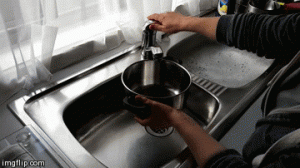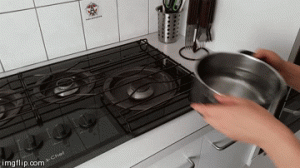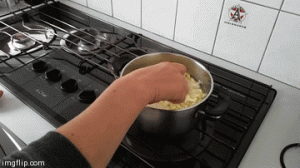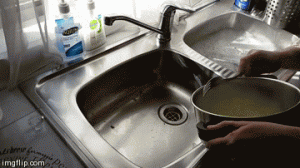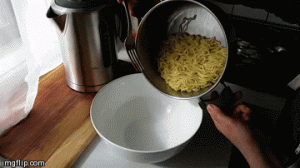This video explores how interactivity can be used in creating an instructional video. This video allows the user to navigate between the steps at their own pace while learning how to bake a cake in a humorous and creative fashion. It uses both text and illustrations to show what is required from the user in a simple and easy-to-use way. The key advantage to this format is that the user has full control over the content as they decide whether they would like to continue to the next stage, stay where they are or repeat a previous step. The video is fairly linear as the viewer only has the choice to go forwards or backwards rather than going off track. The audience just gets the visuals required to understand the steps involved to keep the animation as simple as possible. I feel this video is successful as it gives a clear and visually stimulating way to present the information to the viewer while still allowing the viewer have control over the video.
OVE – Project 3 – Video 5 – How to cook noodles? (Montage – Non-linear)
Cooking Noodles Montage from Troy on Vimeo.
Since the previous videos were very linear in nature I decided for this video to try and create something as non-linear as possible while still retaining the instructional element. I used the videos filmed for the previous sketches and layered them on top of each other as well as changing the ordering and positioning to create a montage of steps forcing the viewer to try and find a pattern between what they are seeing and the steps required to complete the process. As far as the non-linear aspect, the video works well in that in engages your attention and gives you all of the information at a fast pace. The video however is very distracting due to the multiplicity of the videos and sounds mashed together as well as being non-linear makes it almost impossible to follow the cooking process. The viewer struggles to follow what is happening as naturally your eyes follow each video as they pop up on the screen rather than the natural sequence of events.
OVE – Project 3 – Video 4 – How to cook noodles? (GIF’S)
What makes a video a video? According to the internet it is a sequence of images processed electronically at a speed to create the illusion of motion and continuity. So I decided for this video to create a deconstructed video using GIF’s and royalty-free music. I found this idea interesting in that it is both linear and non-linear depending how you look at it since all of the content is available to the viewer at the same time and they choose what image to view first. The one issue I have with this video is if it is indeed considered a video as it contains all of the elements of a video without any of the connecting elements i.e. everything is separated into different files/pieces of content. Similar to the Vine video this forced me to adopt a different way of thinking; would it still make sense if I chopped/shorted this and does this work as a loop. The audience just gets the visuals and the bare-minimum required to understand and follow the steps. I feel the concept is successful in that it is short, quick and to the point without sacrificing on quality or clarity.
OVE – Project 3 – Video 3 – How to cook noodles? (Korsakow)
Korsakow Film (Need to be signed into RMIT account to download)
For this video I tried to use the existing video footage that I had filmed to create a sequence that was both non-linear and interactive. I used Korsakow to achieve this by opening up an initial video and then giving the user three different options as to which video to play next, until all of the videos have been played. The viewer can choose to play the videos in any sequence allowing them to interact with the footage. It works to a certain extent as it is visually appealing and makes the user the one who is in control of the content, however as an instructional video it is fairly useless. There is little to no guide to the user as to where they should start or finish but rather just a series of slightly linked videos. If the task was more complex than what I have presented, the Korsakow film method would be of little to no use. For the next task I want to create something with slightly more of a structure but still adopting the non-linear approach.
OVE – Project 3 – Video 2 – How to cook noodles? (Vine)
Cooking Noodles Vine from Troy on Vimeo.
My aim for this this video was to see what other methods I can use to create an instructional video and how compact the video could be made without losing its effectiveness. By using the online web service, Vine, I feel I have managed to achieve both aims successfully. Using Vine forced me to adopt a different way of thinking; what needed to be captured in the six seconds of footage rather than what would look the best cinematically and how I can show this in as short a time as possible. Each instruction is shown in sequence with no voice over or music present. The audience just gets the visuals and the bare-minimum required to understand and follow the steps. I wanted to see if a quick glance at each shot could still covey the instructions to the simple cooking task. I feel the video is successful in that it is short, quick and to the point. If the instructions were more complex I do not feel that this type of video method would suffice as it does not allow the audience to have a lengthy period of thought.
OVE – Project 3 – Video 1 – What not to put in a microwave?
What not to put in a microwave from Troy on Vimeo.
For project 3 our aim was to explore the instructional elements of our previous videos and see how they can be presented in different forms. For this video I adopted a linear approach, that is listing all of the items that should not be placed in a microwave. This was effectively done with me talking to the camera and then jump cuts of various items being placed into the microwave. I made this video as a start point for the direction in which I wanted to head towards in this project. In the previous project I used more of a linear approach in creating the videos. I then started in a similar fashion with this video and in subsequent video I want to try and explore different ways in which to present the same information using different methods, media and technologies. The key thing I have discovered which is necessary when creating/producing a successful instructional video is to have a simple idea where steps are involved and to present them clearly. The viewer is capable of filling the blanks as long as they are aware of what is being presented or implied to them.
Project 3 – The Ideas
- Instructional
- What kind of video practice can we explore around instructional structure?
- What happens if we apply that to a different context?
- Instructional context
- Using lists of things to influence work
- Awkwardness/Gaps, dead space
- What is considered to be awkward?
- Can dead be considered entertaining
- Exaggerated/Overdone
- How much is too much?
Our focus is on the instructional element mainly the cause and effect of doing certain things. We aim to see how listing can influence our work and what happens if we apply the instructional element to different video practices and contexts. We also want to incorporate the awkwardness and exaggerated elements. Using this instructional element we are aiming to explore the different forms in which we can present this information using a range of online media and services.
How can we manipulate instructional videos using different forms and services and therefore create new content?
- Silent instructional video
- How are these things related?
- Sketched instructional video
- Food getting eaten
- Dog eating food off floor at multiple camera angles
- Mixer with really sad music playing slowed down
- Make a cake no instructions
- Overly dramatic cooking
- Exploding egg microwave
- Animation something
- Guy putting on make-up
- Slashing fruit
- Wrong/Stupid ways to cook (animation)
- Things you can put in a microwave
- Cooking with a saucepan and a candle
Beginning Project 3
Just begun work on project 3 and Seth has introduced a new way of working; Satisficing which relies on quantity rather than quality. For this assignment the task is to produce as many sketches as possible to explore new ideas and to use as many or as little of the set criteria as necessary.
At this stage I feel that this is going to be a good way of working as it removes the pressure of whether or not good work is being produced and allows you to explore ideas that may not have been explored otherwise.
Where are we going in project three?
After the presentation for Assignment 2 Seth has advised our group to focus more on the form rather than the content of the videos so for project three the aim for our videos is to focus on the instructional element of the videos and how it can be integrated into other genres as our stronger videos seem to be the more structured ones like the makeup tutorial and how to make a glass of juice.
We hope to also try and combine elements from our sketch videos and try and create some complete works rather than elements of one piece of work.
Personally I feel that we should in the next assignment establish a clearer set of guidelines as to what we are out to create rather than creating and then modifying it to fit into the design brief. I.e. Establish a time limit and an aspect to focus on, then create content around these two criteria. I feel that form has been fully explored in the previous assignment and does not need to necessarily be a key focus for this next assignment.
OVE – Concept statement
One issue that we seem to previously had is the concept statement; mainly trying to make videos that fit the concept rather than make the concept fit the videos. I feel like at this point some of the videos I have created are not necessarily filling the criteria. After talking to Seth last class I feel that my later videos are more on task with our refined concept statement and by looking at what Linda had produced gave me a clearer understanding of what the task was asking of me.
If I was to be given this task in the future I feel I will spend more time in the planning stage rather than jumping straight into the producing.
The organic nature of the studio also meant that ideas needed to be ‘thrown away’ which was not something I was used to and felt that I held onto some of my sketches too much.
Next time I need to follow the process more but also be willing to change as the project changes.
